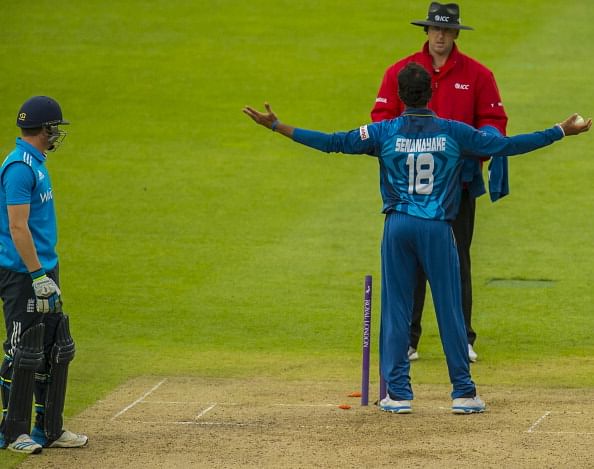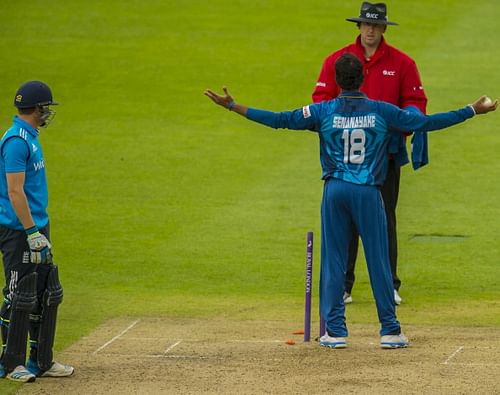
Mankading - The history and rules of the 'controversial' mode of dismissal

The game of cricket has seen many hot controversies in its history and ‘Mankading’ is one of the never ending issue that has opinions from everyone.
In the 5th and final One-day international between the hosts England and Sri Lanka on Tuesday, Sachithra Senanayake ran Jos Buttler out after warning him ealier in his previous over. The umpire Michael Gough, without any hesitation, ruled Buttler out after the Sri Lankan captain chose not to withdraw the appeal.
This started a series of ‘cheat’ claims against the off-spinner and Sri Lanka while many former England cricketers too felt that Sri Lanka had broken the spirit of the game. The Sri Lankan players defended themselves and the English blamed their counterparts.
Even though it was completely legal by the laws of the game, it was considered against the cricketing spirit, despite it being clearly legal by official rules.
The MCC rule:
The MCC (Law 42.15) states that "The bowler is permitted, before entering his delivery stride, to attempt to run out the non-striker. Whether the attempt is successful or not, the ball shall not count as one of the over. If the bowler fails in an attempt to run out the non-striker, the umpire shall call and signal Dead ball as soon as possible."
The above rule was were formed by MCC and normally all the MCC’s rules were approved by ICC before being applied to matches. For many years in international cricket, the rules stated that a batsmen can leave the crease once the bowlers’ backfoot lands on his delivery stride.
ICC rule and the difference:
Many were not aware of a rule change that was implemented since the 1st of October 2011, which gives a bowler complete right to run a batsman out before finishing his complete delivery stride (that means before releasing the ball).
The bowler is permitted, before releasing the ball and provided he has not completed his usual delivery swing, to attempt to run out the non-striker. Whether the attempt is successful or not, the ball shall not count as one of the over. if the bowler fails in an attempt to run out the non-striker, the umpire shall call and signal dead ball as soon possible.
This is where the biggest difference lies in MCC’s and ICC’s ruling. It’s quite absurd to assume that players are unaware of this minute but crucial difference. Once a bowler enters his delivery stride, it does not give the non-striker the freedom to move out of his crease. Unless the bowler has delivered the ball, the non-striker remains at the risk of being ‘Mankaded’. It’s a simple and clear ruling.
Bowlers have always been on the receiving end in this batsman friendly modern times and it is only fair with this rule that gives them a chance to stop batsmen from stealing singles. Mahela Jayawardene pointed out after the deciding fixture against England that the hosts had ran 22 twos in last 12 overs at Lord’s. It’s only fair that they stop the batsmen from getting that head start at the non-striker’s end.
In the high scoring shorter formats of the game, every run is crucial. How many times have we seen games decided by a solitary run or two? In that context, every run saved matters.
If ‘Mankading’ was against the spirit of the game, how fair it is for a batsmen to stay rooted to his crease, not walking for an edge that is given not out. The rules are rules and batsmen better take note of this before attempting for risky singles.
The history behind ‘Mankading’
The name ‘Mankaded’ was attached with this dismissal way back in 1947. During the second Test match against Australia at Sydney, Indian left-arm spinner Vinoo Mankad ran Bill Brown out for the second time in that tour after the warm-up match against Australia XI.
Not very surprisingly, media cried foul, accusing Mankad to have broken the spirit of the game. However he received support for his move even from the opposition camp in the form of their then captain, Donald Bradman.
“For the life of me, I can't understand why [the press] questioned his sportsmanship. The laws of cricket make it quite clear that the non-striker must keep within his ground until the ball has been delivered. If not, why is the provision there which enables the bowler to run him out? By backing up too far or too early, the nonstriker is very obviously gaining an unfair advantage,” revealed Bradman.
Last match was the 8th such instance of ‘Makading’ in international cricket and 4th in one-dayers. Twice it has happened in first class cricket – both by Murali Kartik.
The bowling team will get no credit other than just the so called ‘good boys’ image from the media when the opposition steals a win by a close magin.
On three occasions, either the bowler or the captain refrained themselves from claiming the dismissal. Twice the batting team went on to win the match by one wicket. How spiritful was that for the media.
Courtney Walsh and his West Indies team in the World Cup 1987 lost out on an oppourtunity to qualify for the semifinal as they lost the match for not effecting the run-out.
In 2003, Mohammad Rafique of Bangladesh was too soft on Umar Gul that ended with Pakistan winning the match by 1 wicket. Even though Bangladesh had already lost the series three match series by 2-0, it would have given a rare win for the developing team and prevented a whitewash.